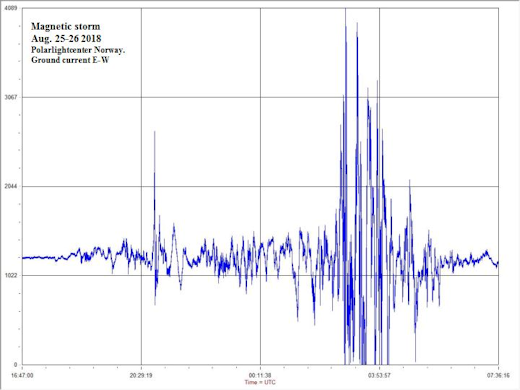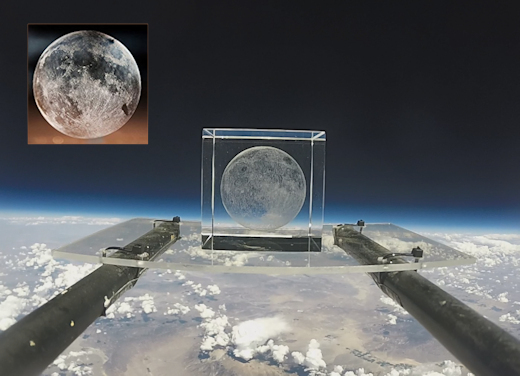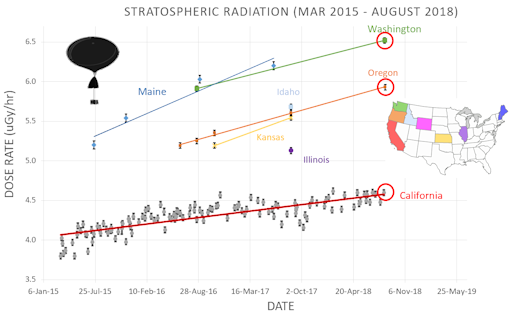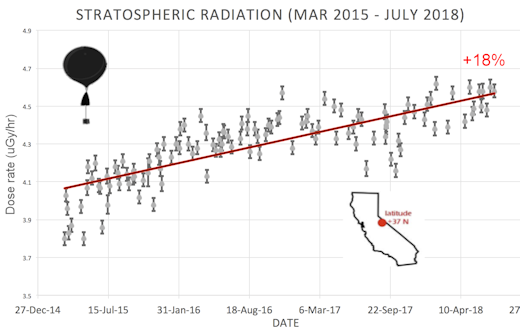Lights Over Lapland has a brand-new website full of exciting adventures in Abisko National Park, Sweden! Take a look at our aurora activities and book your once-in-a-lifetime trip with us today! | | |
GEOMAGNETIC ACTIVITY CONTINUES: G1 to G2-class geomagnetic storms are underway on Aug. 27th as our planet passes through a stream of high-speed solar wind. The gaseous material is flowing from a northern hole in the sun's atmosphere. Earth's magnetic field was already reverberating from a strong geomagnetic storm that erupted over the weekend. The addition of this solar wind stream sets the stage for a new round of Arctic auroras tonight. Free: Aurora Alerts.
ELECTRICITY FLOWS THROUGH THE SOIL OF NORWAY: When a geomagnetic storm erupts, most eyes naturally turn to the sky, looking for auroras. But during the surprisingly strong G3-class geomagnetic storm of Aug. 26th, there was action underfoot as well. Probes buried in the ground in Norway detected strong currents of electricity moving through the soil. This chart recording made by Rob Stammes at the Polarlightcenter in Lofoten shows wild swings in current during the storm's peak:

"The currents were remarkably strong," says Stammes, who has been monitoring ground currents outside his Arctic observatory for many years. "During the magnetic storm, voltages surged to 10mv/m or 10v/km. That's about 10 times stronger than normal. These are pretty rare readings without a strong solar flare during solar minimum."
Why does electricity flow through the ground during a geomagnetic storm? It's basic physics. Changing magnetic fields cause currents to flow in wires and other conductors. In most places, soil can conduct electricity due to the presence of dissolved salts and minerals. So when the local magnetic field begins to vibrate, electricity naturally begins to flow. Currents induced by geomagnetic storms can cause voltage fluctuations in power systems and in rare cases complete blackouts.
Realtime Aurora Photo Gallery
LASER-ETCHED MOON CUBE: On August 16, 2018, the students of Earth to Sky Calculus launched a cosmic ray balloon to the stratosphere. This unique laser-etched Moon cube went along for the ride, ascending to an altitude of 101,140 feet:

You can have it for $149.95. The students are selling these cubes as a fund-raiser for their cosmic ray ballooning program. It's an authentic representation of the Moon, with all of the craters, mountains and lava plains accurately portrayed.
Each Moon-cube comes with a unique gift card showing the item floating at the top of Earth's atmosphere. The interior of the card tells the story of the flight and confirms that this gift has been to the edge of space and back again.
Far Out Gifts: Earth to Sky Store
All sales support hands-on STEM education
ATMOSPHERIC RADIATION UPDATE: Spaceweather.com and the students of Earth to Sky Calculus are in the middle of a cosmic ray ballooning campaign, visiting places we've been before to update our measurements of atmospheric radiation across the USA. On August 16th through 21st, we launched a series of balloons to the stratosphere from Bishop, CA; John Day, OR; and Wenatchee, WA. We found radiation levels increasing up and down the Pacific Coast. The latest data points are circled red:

Why is cosmic radiation increasing? Mainly, it's due to the solar cycle. As the sun plunges into a deep solar minimum, the sun's magnetic field is weakening. Solar wind pressures are declining as well. As a result of these changes, cosmic rays from deep space are finding it easier to penetrate the inner solar system. Surging cosmic rays hit the top of Earth's atmosphere, creating a downward spray of secondary particles and radiation that we detect using sensors on high-altitude balloons.
Our recent balloon launches from multiple US states as well as Sweden, Norway, Chile, Mexico and New Zealand confirm that cosmic rays are intensifying everywhere, but not by the same amount in all places. For instance, in the latest data we see that atmospheric radiation above Washington is almost 50% stronger than radiation above central California--a significant difference considering that the two launch sites are separated by only ~900 miles and 10 degrees of latitude. This shows that Earth's magnetic field is an uneven shield against incoming cosmic rays, protecting some places more than others.
Next week we'll be launching a cosmic ray balloon from Kansas and, soon thereafter, from Maine to extend our monitoring across the continental USA. Stay tuned.
Realtime Space Weather Photo Gallery
Every night, a network of
NASA all-sky cameras scans the skies above the United States for meteoritic fireballs. Automated software maintained by NASA's Meteoroid Environment Office calculates their orbits, velocity, penetration depth in Earth's atmosphere and many other characteristics. Daily results are presented here on Spaceweather.com.
On Aug. 27, 2018, the network reported 13 fireballs.
(13 sporadics)

In this diagram of the inner solar system, all of the fireball orbits intersect at a single point--Earth. The orbits are color-coded by velocity, from slow (red) to fast (blue). [Larger image] [movies]
Potentially Hazardous Asteroids (
PHAs) are space rocks larger than approximately 100m that can come closer to Earth than 0.05 AU. None of the known PHAs is on a collision course with our planet, although astronomers are finding
new ones all the time.
On August 27, 2018 there were 1912 potentially hazardous asteroids.
 |
Recent & Upcoming Earth-asteroid encounters: | Asteroid | Date(UT) | Miss Distance | Velocity (km/s) | Diameter (m) |
| 2018 PK9 | 2018-Aug-22 | 17 LD | 9 | 33 |
| 2018 PW7 | 2018-Aug-23 | 11.3 LD | 10.6 | 50 |
| 2018 QF1 | 2018-Aug-23 | 18.1 LD | 14.3 | 75 |
| 2018 PU23 | 2018-Aug-23 | 7.8 LD | 1.5 | 8 |
| 2018 PR9 | 2018-Aug-24 | 18.1 LD | 14 | 46 |
| 2018 QH1 | 2018-Aug-27 | 13.2 LD | 12.5 | 27 |
| 2018 LQ2 | 2018-Aug-27 | 9.4 LD | 1.5 | 39 |
| 2016 GK135 | 2018-Aug-28 | 16.8 LD | 2.8 | 9 |
| 2016 NF23 | 2018-Aug-29 | 13.2 LD | 9 | 93 |
| 1998 SD9 | 2018-Aug-29 | 4.2 LD | 10.7 | 51 |
| 2018 DE1 | 2018-Aug-30 | 15.2 LD | 6.5 | 28 |
| 2001 RQ17 | 2018-Sep-02 | 19.3 LD | 8.3 | 107 |
| 2015 FP118 | 2018-Sep-03 | 12.3 LD | 9.8 | 490 |
| 2018 QA | 2018-Sep-03 | 17.5 LD | 20.4 | 73 |
| 2017 SL16 | 2018-Sep-20 | 8.5 LD | 6.4 | 25 |
| 2018 EB | 2018-Oct-07 | 15.5 LD | 15.1 | 155 |
| 2014 US7 | 2018-Oct-17 | 3.2 LD | 8.7 | 19 |
| 2013 UG1 | 2018-Oct-18 | 10.4 LD | 13.4 | 123 |
| 2016 GC221 | 2018-Oct-18 | 8.7 LD | 14.4 | 39 |
Notes: LD means "Lunar Distance." 1 LD = 384,401 km, the distance between Earth and the Moon. 1 LD also equals 0.00256 AU. MAG is the visual magnitude of the asteroid on the date of closest approach. | | Cosmic Rays in the Atmosphere |
SPACE WEATHER BALLOON DATA: Approximately once a week, Spaceweather.com and the students of Earth to Sky Calculus fly space weather balloons to the stratosphere over California. These balloons are equipped with radiation sensors that detect cosmic rays, a surprisingly "down to Earth" form of space weather. Cosmic rays can seed clouds, trigger lightning, and penetrate commercial airplanes. Furthermore, there are studies ( #1, #2, #3, #4) linking cosmic rays with cardiac arrhythmias and sudden cardiac death in the general population. Our latest measurements show that cosmic rays are intensifying, with an increase of more than 18% since 2015:

The data points in the graph above correspond to the peak of the Reneger-Pfotzer maximum, which lies about 67,000 feet above central California. When cosmic rays crash into Earth's atmosphere, they produce a spray of secondary particles that is most intense at the entrance to the stratosphere. Physicists Eric Reneger and Georg Pfotzer discovered the maximum using balloons in the 1930s and it is what we are measuring today.
En route to the stratosphere, our sensors also pass through aviation altitudes:

In this plot, dose rates are expessed as multiples of sea level. For instance, we see that boarding a plane that flies at 25,000 feet exposes passengers to dose rates ~10x higher than sea level. At 40,000 feet, the multiplier is closer to 50x.
The radiation sensors onboard our helium balloons detect X-rays and gamma-rays in the energy range 10 keV to 20 MeV. These energies span the range of medical X-ray machines and airport security scanners.
Why are cosmic rays intensifying? The main reason is the sun. Solar storm clouds such as coronal mass ejections (CMEs) sweep aside cosmic rays when they pass by Earth. During Solar Maximum, CMEs are abundant and cosmic rays are held at bay. Now, however, the solar cycle is swinging toward Solar Minimum, allowing cosmic rays to return. Another reason could be the weakening of Earth's magnetic field, which helps protect us from deep-space radiation.
| | The official U.S. government space weather bureau |
| | The first place to look for information about sundogs, pillars, rainbows and related phenomena. |
| | Researchers call it a "Hubble for the sun." SDO is the most advanced solar observatory ever. |
| | 3D views of the sun from NASA's Solar and Terrestrial Relations Observatory |
| | Realtime and archival images of the Sun from SOHO. |
| | from the NOAA Space Environment Center |
| | fun to read, but should be taken with a grain of salt! Forecasts looking ahead more than a few days are often wrong. |
| | from the NOAA Space Environment Center |
| | the underlying science of space weather |
 | If you are a Youtuber and want to buy real Youtube views than try out Buyrealsocial.com for the best results possible! |
 | To find reviews of new online casino sites in the UK try The Casino DB where there are hundreds of online casino reviews complete with bonuses and ratings. |
| | These links help Spaceweather.com stay online. Thank you to our supporters! |
| | | | | | |

